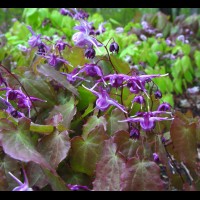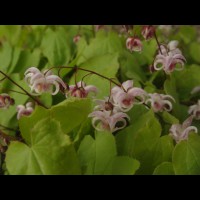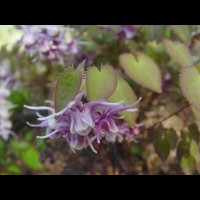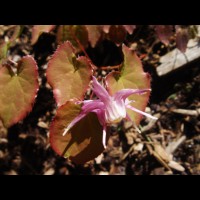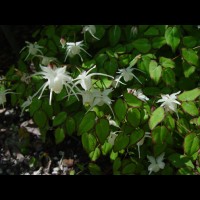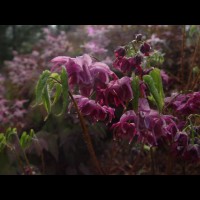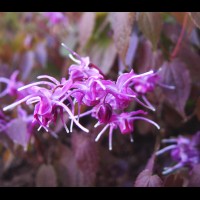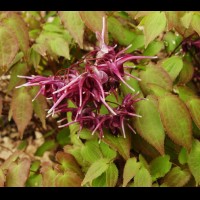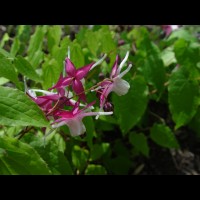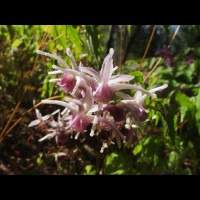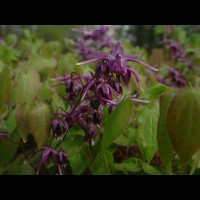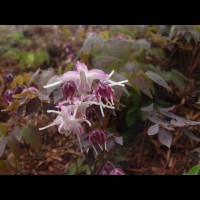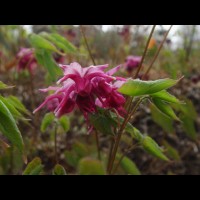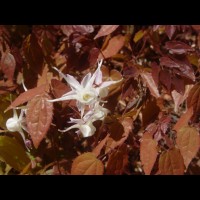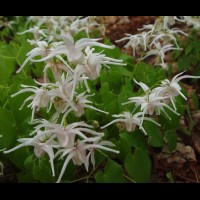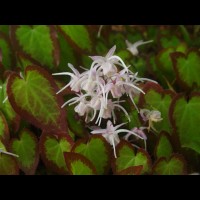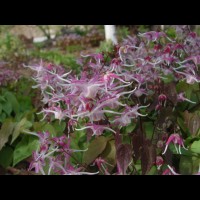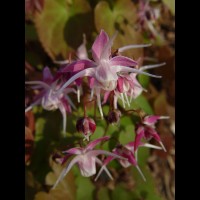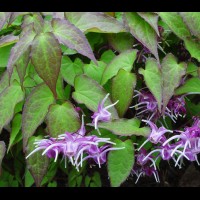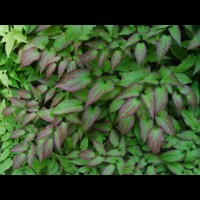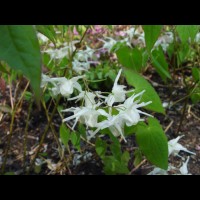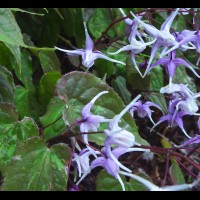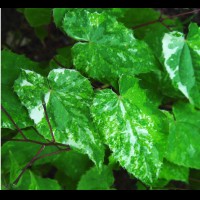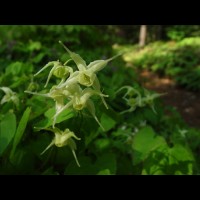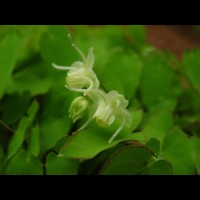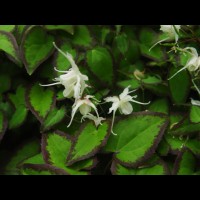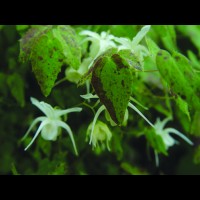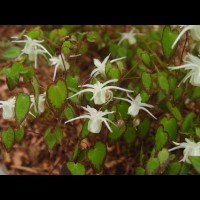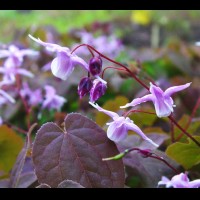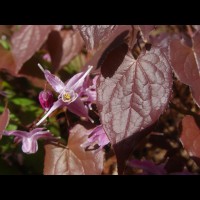Epimedium grandiflorum
Native to Japan, although represented solely by forma flavescens in northern Japan. It is the most variable species of Epimedium. Medium/large flowers in a wide range of colors, with long spurs and a “cup”. Leaflets generally small/medium, with 9-27 per leaf. Most produce a second flush of taller leaves shortly after bloom. We provide two height measurements: the first for bloom time and then the ultimate height. Clump-forming unless otherwise noted. Deciduous. Sometimes grows poorly in alkaline soils with the exception of variety higoense.
Epimedium grandiflorum
E. grandiflorum (Cc. 920009) (Synonym: E. macranthum)
The typical form of the species in the U.S., with rosy inner-sepals, and creamy-white spurs and cup. The small new spring leaflets have a brown-purple cast to them that nicely complements the flower color. 7" tall in bloom, with a second growth flush to 14".
Epimedium grandiflorum 'Album'
E. grandiflorum ‘Album’ (Cc. 950063)
A favorite of Darrell's since the first time he saw it in Harold Epstein’s garden, as it really stands out, very fresh and bright in the spring. Originally imported from Japan, it has large, pristine white flowers suspended above small, crisp apple green spring leaflets for a strikingly clean contrast. 6” tall in bloom, second flush reaches 12-14”. Not as strong a grower as many other E. grandiflorum varieties.
Epimedium grandiflorum 'Benedict's Violet'
E. grandiflorum ‘Benedict’s Violet’ (Cc. 950130)
This seedling originated in Dr. Herb Benedict’s garden in Hillsdale, MI. Large, reddish-grape flowers hover over young spring green leaflets with a rosy edge. 9” tall with no second growth flush. Very floriferous. A shorter Epimedium that quickly forms a clump.
Epimedium grandiflorum 'Bicolor Giant'
E. grandiflorum ‘Bicolor Giant’ (Cc. 970206)
Bold, cheerful and bright flowers and later the large leaves both make a nice show from a distance. The large flowers exhibit in-curved sugary pink spurs under wide, deep raspberry sepals. The flowers bloom from underneath the leaves, but are produced in such profusion, that they are showy nonetheless.
After bloom, the large new spring leaflets blush with red before turning to their summer green. Another giant red similar to ‘Red Queen’ and ‘Orion’, but with a bi-colored bloom. Acquired in from Gotemba Nursery, Japan in 1997 as a “pink grandiflorum”. 16” tall in flower. It has exhibited yellow, rusty orange and maroon fall colors here in Massachusetts. Forms a substantial clump that reads as a small shrub in the perennial border.
Epimedium grandiflorum 'Circe'
E. grandiflorum ‘Circe’ (Cc. 950244)
***2006 Cobblewood Introduction***
Beautiful large rose-red flowers accented with white spur tips have caught the eye of many a visitor to our open nursery weekends. This cultivar has much the same characteristics to recommend it as Epimedium grandiflorum ‘Yubae’ but with 2-3 times the number of bloom stems held above the foliage, and a shorter stature. Heavily flowered with a slightly darker cast to the young foliage. Medium-sized leaflets form a mound to 13”. An early bloomer hybridized by Darrel Probst.
Epimedium grandiflorum 'Cranberry Sparkle'
E. grandiflorum ‘Cranberry Sparkle’ (Cc. 950162)
***2002 Cobblewood™ Introduction***
Darrell’s friend Don Elick spent five days in April 1995 on a whirlwind dash through southern Japan searching for select forms of wild Epimediums that might prove useful in Darrell’s breeding program. This was his most incredible find with large, rich cranberry flowers held out horizontally on 6” stems. The small leaflets are flushed bronze in spring. Very, very late to emerge and one of the last grandiflorums to bloom. 10” tall.
Epimedium grandiflorum 'Dark Beauty'
E. grandiflorum ‘Dark Beauty’ (Cc. 950132)
Harold Epstein admired this plant for its velvety, deep chocolate-purple new spring foliage. It appeared as a seedling in his garden from an apparent cross between ‘Yubae’ and ‘Silver Queen’. Its large flowers have beautiful dark rose inner-sepals and white petals/spurs flushed with rose. Small leaflets. 8” in bloom with second flush to 12”. A strong grower and one of the first “Eps” to emerge and bloom each year in the nursery.
Epimedium grandiflorum 'First Kiss'
E. grandiflorum ‘First Kiss’ (Cc. 920019)
One of the smallest grandiflorums. Large flowers are produced just above the first set of leaves at only 4” tall. Dark lavender-rose flowers have white accents on the rim of the cup and the spur tips. Small spring leaflets are flushed purple. Second flush to 9”. Its short stature makes it great for troughs or the front of the shade border.
Epimedium grandiflorum 'French Braid'
E. grandiflorum ‘French Braid’ (Cc. 960042)
***2007 Cobblewood Introduction***
This eye-catching, vigorous, bold-foliaged seedling from Harold Epstein’s garden stands out from the pack with its bright, almost tropical spring leaf coloration. A psychedelic shade of orange flushes the edge of the leaflets that are dissected by luminous chartreuse veins flowing into an all green center. Large, elongated, overlapping leaflets tumble downward in a zig-zag pattern. Large creamy white flowers are borne underneath the expanding leaflets. 14” in bloom.
Epimedium grandiflorum 'Lavender Lady'
E. grandiflorum ‘Lavender Lady’ (Cc. 950094)
***2000 Cobblewood Introduction***
This beauty appeared as a seedling in Harold’s garden as a cross between E. sempervirens ‘Violet Queen’ and E. grandiflorum ‘Silver Queen’. Its red leaf color comes from the former and its numerous leaflets from the latter. It forms a mass of wide-spreading, low-growing leaves composed of medium-sized leaflets, their edges suffused with a deep red that fades into a soft green, netted center. This beautiful mass of foliage is topped by full panicles of large, lavender flowers with white spur tips. 8” tall in bloom. No second growth flush. Striking reddish-orange fall color. Early bloomer with a distinctly horizontal growth habit. Semi-evergreen.
Epimedium grandiflorum 'Lilac Seedling'
E. grandiflorum ‘Lilac Seedling’ (Cc. 960019)
Friend Teyl de Bordes of Scotland selected this outstanding seedling from a batch at Washfield Nursery. Medium-large, arrow-shaped leaflets emerge a spectacular deep reddish-purple in spring etched in bright green along the main veins. The color remains for about a month before turning green. 12-18” tall. Dense heads of large light lavender and white flowers are produced below the new leaves. Very showy.
E. grandiflorum 'Lilafee'
Epimedium grandiflorum 'Lilafee' (Cc. 910001)
A popular favorite for its large, delicate, violet-purple flowers with white spur tips held above small, purple-tinted spring leaflets. Reaches 8” tall in bloom with a second flush to 14” tall.
Epimedium grandiflorum 'Mizuhomaru'
E. grandiflorum ‘Mizuhomaru’ (Cc. 970236)
(Synonym: ‘Sakaru Moru’)
A curious Japanese cultivar with spurs that curve sharply inward towards the cup in cold temperatures. This unique flower form makes it a popular choice when seen in bloom at our on-site nursery sales. Medium-sized, pale lavender-purple flowers. Small leaflets. 8” tall in bloom; second growth flush to 12”. Leaves sometimes turn shrimp pink in the fall.
Epimedium grandiflorum 'Mt. Kitadake Purple'
E. grandiflorum ‘Mt. Kitadake Purple’ (Cc. 950031)
Large, intensely rose-violet flowers are held above richly colored foliage. White highlights along the outer edges of the flower resemble crisp white piping. The muted red tones of the early spring foliage later fade to a rosy band at each leaf edge, encircling a light green center with a slight rose blush. The small leaflets are fringed with long white spines, likened to white eyelashes by one of my more enthusiastic customers! 6-7” in bloom, second flush to 10”.
Epimedium grandiflorum 'Mt. Kitadake Red'
E. grandiflorum ‘Mt. Kitadake Red’ (Cc. 960020)
A darling little plant, beginning its bloom with leaves only 5” tall. The large, rose-red flowers are held above the foliage at 7” high. A second flush of leaflets follows on stems to 10”. Each small leaflet is tinted with bronze to dark reddish-purple in spring. This clone has exhibited pink and yellow fall color in the nursery.
Epimedium grandiflorum 'Nanum'
Epimedium grandiflorum ‘Nanum’ (Cc. 950149)
Perfect for a shady trough garden or border edge at only 3-5” in bloom. Second growth flush of foliage later reaches 10” in height. Medium-sized white flowers are in proportion to the size of the plant as are the tiny, rounded spring leaflets, each with a light purple band around their edge in spring. Particularly late to emerge in spring.
Epimedium grandiflorum 'Orion'
E. grandiflorum ‘Orion’ (Cc. 920020)
A giant “red" flowered Epimedium, probably originating from central Honshu in Japan. Grows 14 to 18” tall at bloom time, with large leaflets, and no second flush of growth. Large violet-red flowers are produced in profusion held below the large, bold leaflets. Flower color reads from a distance in the garden. Named by Dick Weaver.
Epimedium grandiflorum 'Pierre's Purple'
E. grandiflorum ‘Pierre’s Purple’ (Cc. 950124)
***1999 Cobblewood Introduction***
Named for Pierre Bennerup of Sunny Border Nurseries who originally shared it with Darrell. 7” tall in bloom, with a second growth flush to 15”. Beautiful, large, rich wine-purple flowers with white spur tips are borne against small leaflets flushed bronze in early spring. The intense spring color of the leaflets elicits many comments during our bloom season, but gradually fades as the flowers age. Leaflets turn a limey green in mid-autumn.
Epimedium grandiflorum 'Princess Susan'
E. grandiflorum ‘Princess Susan’ (Cc. 960044)
***1999 Cobblewood Introduction***
A beautiful, large-flowered selection from Harold Epstein’s garden, named after his daughter. Flowers are a crisp contrast of cherry-rose inner-sepals and pure white petals/spurs against small, bright green leaflets. Foliage grows more horizontally than that of other Epimediums. 8” in bloom with a second growth flush to 13”. A late bloomer.
Epimedium grandiflorum 'Pseudo Larchmont'
E. grandiflorum ‘Pseudo-Larchmont’ (Cc. 950115)
***1998 Cobblewood Introduction***
This unusually large, floriferous clone bears masses of creamy-lavender and purple blossoms with arching spurs that billow out from under the edges of the foliage. As a rule, it produces only 9 leaflets per leaf, instead of up to 15, giving bolder texture. The leaflets are dark green, narrow, and distinctively angular in shape. A strong grower, ‘Pseudo-Larchmont’ grows to 8” in bloom, with a second growth flush to 20+”.
Epimedium grandiflorum 'Purple Prince'
E. grandiflorum ‘Purple Prince’ (Cc. 950123)
The richest, deepest purple form of E. grandiflorum that we’ve ever seen. Visitors often remark at its exceptional beauty, even in bud. Spring leaves emerge a muted rose. 8” tall in bloom, with a second flush to 18”. Small leaflets, medium-sized flowers. An early bloomer.
Epimedium grandiflorum 'Queen Esta'
E. grandiflorum ‘Queen Esta’ (Cc. 920021)
A beautiful cultivar named by Harold Epstein after his wife, Esta. It was the first named seedling ever introduced from his garden. Notable for its large flowers with dark lavender inner-sepals and pale lavender spurs held against the chocolate-brown new spring foliage. It grows 6-8” tall in bloom, with a second flush of new dark leaves to 12”. Small leaflets. One of the earliest E. grandiflorums to bloom in spring.
Epimedium grandiflorum 'Red Queen'
E. grandiflorum ‘Red Queen’ (Cc. 950055)
Harold Epstein bought this imposing plant in Japan many years ago, and nicknamed it “Red Queen”. As far as we can determine, it was not a named cultivar. Large, vivid, rose-red flowers peek out from under huge leaflets that may grow to 6” long/4” wide. The bold fall foliage of this regal Epimedium sometimes turns shades of pink/orange. A second growth flush of red-tinted foliage reaches to 14”. A vigorous, bold-textured choice that makes a substantial clump over time.
Epimedium grandiflorum 'Shiratama'
Epimedium grandiflorum ‘Shiratama’ (Cc. 970068)
Ozzie Johnson of Marietta, GA brought back this striking cultivar from Japan. It produces masses of delicate 1” pristine white flowers with long, thin, elegant and prominently curved spidery spurs above a bun of medium-sized, bright apple-green leaflets at only 5” tall. Crisp and clean look to flowers and foliage. Second growth flush to 14”.
Epimedium grandiflorum 'Silver Queen'
E. grandiflorum ‘Silver Queen’ (Cc. 900003)
Very textural with leaves usually divided into 27 small leaflets that are mahogany-flushed in spring. The large white flowers have "silvery-lavender" highlights on the inner-sepals. 7" tall in bloom, second flush to 11". A parent of many cultivars. An early bloomer.
Epimedium grandiflorum 'Sirius'
E. grandiflorum ‘Sirius’ (Cc. 920024)
A 1990 Dick Weaver introduction, ‘Sirius’ originated as a seedling in Harold Epstein’s garden. The large and delicate palest of pink flowers float above small, distinctively light green leaflets. Often only 5” tall in bloom, with a second flush of growth to 10”. Blooms at the "tale-end" of the Epimedium season.
Epimedium grandiflorum 'Spring Wedding'
E. grandiflorum ‘Spring Wedding’ (Cc. 950237)
2003 Cobblewood Introduction
The fresh spring foliage of this selection emerges dark purple, then lightens and expands to display a bold, 1/4” wide, mahogany-red edge. Very floriferous, it produces numerous flower stems held well above the foliage. The medium-sized flowers have soft lavender sepals backing white petals with downward curving spurs. A plant handsome in both flower and foliage. 10” tall in bloom. Semi-evergreen leaflets hold well into autumn when they turn a limey shade of green. It tolerates alkaline soils better than most E. grandiflorums.
Epimedium grandiflorum 'Swallowtail'
E. grandiflorum ‘Swallowtail’ (Cc. 950238)
***2003 Cobblewood™ Introduction***
A flurry of slim, streamlined and graceful, medium-sized flowers are borne both above and among the numerous small leaflets edged with a hint of purple. The second growth flush has even better foliage color for an extended season of beauty. The flowers have sepals that are blue-lavender streaked in rose. Angular white spurs have a lavender streak and a slight downward tilt. 7” in bloom with a very horizontal growth habit. Second growth to 12". Unlike most grandiflorums, it tolerates alkaline soils.
Epimedium grandiflorum 'Tama No Genpei'
E. grandiflorum ‘Tama No Genpei’ (Cc. 950039)
A floriferous, showy Japanese selection with masses of large, crisp, bi-colored lavender/pink and white flowers held above the foliage. The lovely flowers paired with attractive purple-flecked new spring foliage gives the plant a very soft look in bloom. First blooms are held on 8” stems, with stems elongating to 16”. Small leaflets.
Epimedium grandiflorum 'Waterfall'
E. grandiflorum ‘Waterfall’ (Cc. 950113)
***2003 Cobblewood Introduction***
A large, lively, textural garden plant, full of movement. This appeared as a spontaneous seedling in the garden of Harold Epstein between E. grandiflorum f. flavescens ‘La Rocaille’ and E. grandiflorum ‘Yubae’. The medium-large, acutely tapered leaves stack in layers giving the appearance of flowing water. In spring, purple stippling is strongest at leaf edge, with an irregular mosaic of purple/red and green in the center, fading to green at the petiole. Large flowers gush forth on stems angled upward along the fringes of the foliage. Deep rose-purple sepals angle back from white spurs that flush amethyst as they near the narrow cup. 16” in bloom with colorful second growth to 20".
Epimedium grandiflorum 'White Queen'
E. grandiflorum ‘White Queen’ (Cc. 950168)
Common in the U.K., but quite rare in the U.S., Darrell received his original start of this cultivar from Dan Hinkley upon their first meeting in 1995. ‘White Queen’ has handsome, medium-sized, dark green arrow-shaped leaflets on stems to 14”. It produces no second growth flush. The edges of leaflets are flushed red in spring, while masses of large pure white flowers bloom just below the foliage.
Epimedium grandiflorum 'White Splash'
E. grandiflorum ‘White Splash’ (Cc. 970198)
Early spring leaflets are marked in a bright batik of olive, apple green, soft salmon-pink and white. As the foliage matures, the pink fades, leaving white irregular patches against a patchwork of many shades of green, lasting well into the season.
This plant came from Japan as “E. grandiflorum – Variegated”. We gave it a cultivar name to distinguish it from the others sold as such in Japan. Flowers are similar to those of the species, with medium-lavender inner sepals and white spurs. A smudge of lavender decorates the white cup. To 12” high.
Epimedium grandiflorum 'Yellow Princess'
E. grandiflorum ‘Yellow Princess’ (Cc. 940547)
***2000 Cobblewood Introduction***
Simply beautiful, the small leaflets of this form a low 5-1/2” mass with large, clean, light yellow flowers held aloft on stems to 10”. The spent flower stems are eventually engulfed by a second growth flush. From high elevations in Japan, it emerges late and is one of the last of E. grandi
Epimedium grandiflorum 'Yubae'
E. grandiflorum ‘Yubae’ (Cc. 920022)
(Synonyms: ‘Crimson’, 'Crimson Beauty’, 'Rose Queen’)
One of my favorites, this plant is often mislabeled as ‘Rose Queen’. It arrived in the west many decades ago, already given the name ‘Yubae’ in Japan, but with only Japanese characters to go by and no translation it was probably soon given an English cultivar name. Incidentally, this same plant suffered a third renaming in the U.K. when another plant, ‘Tama No Genpei’, was going around as ‘Rose Queen’ so it was re-named ‘Crimson Beauty’, perpetuating the confusion.
Yubae’s beautiful large rosy-red flowers have white spur tips. This bright flower color can read from a long distance in the garden. The young foliage, purple-bronze in spring, is only 8” tall at first bloom. A second flush of flowers and foliage reaches 18”. Early bloomer.
Epimedium grandiflorum var. coelestre 'Alpine Beauty'
E. grandiflorum var. coelestre ‘Alpine Beauty’ (Cc. 950058)
***2000 Cobblewood Introduction***
Extremely rare in the wild and in cultivation, this is the only Epimedium that grows at montaine heights. Beauti
Epimedium grandiflorum var. higoense 'Bandit'
E. grandiflorum var. higoense ‘Bandit’ (Cc. 950057)
Although Darrell has obtained this clone from several sources, he has traced it back to a 1981 We Du Nursery purchase from Japan. It is very different from the clone he got from them eleven years later. After many years of trialing, he named it in 2000 as it is very distinct and has the most striking, dark purple band around the edge of each small leaflet as it emerges in spring. Medium-sized, creamy-white flowers cover the plant at 6” tall, with a second flush of banded leaves to 10” as the older leaves green up. A customer favorite.
Epimedium grandiflorum var. higoense 'Confetti'
E. grandiflorum var. higoense ‘Confetti’ (Cc. 960144)
***2007 Cobblewood™ Introduction***
A marvel of texture. Each leaf is composed of up to 50 small leaflets, and most are uniquely speckled, flecked and splotched with dark purple in spring. Our leafiest clone of Epimedium by far. 7” high in bloom, bearing hordes of elegantly crafted, medium-sized white flowers. All flower parts are thin and tapered, the whole giving the effect of delicate spiders floating over the foliage.
Epimedium grandiflorum var. higoense 'Saturn'
E. grandiflorum var. higoense ‘Saturn’ (Cc. 920023)
A 1991 We Du introduction named by Dick Weaver for the maroon band that circles each tiny spring leaflet. Only 4 to 5” tall in bloom, the second growth flush may reach 8”. Medium-sized, creamy-white flowers. Foliage provides a fine-textured effect in the garden. Later to bloom than most grandiflorums.
Epimedium grandiflorum var. violaceum
E. grandiflorum var. violaceum (Cc. 890001)
Exquisite deep chocolate, small, spring leaflets form a lovely background for the bright, medium- lavender flowers. One of the very earliest Epimediums to emerge and bloom in the nursery. Makes a clump 8-10” in bloom, with a second growth flush to 12”.
Epimedium grandiflorum var. violaceum 'Bronze Maiden'
E. grandiflorum var. violaceum ‘Bronze Maiden’ (Cc. 920016)
***1999 Cobblewood Introduction***
Spring leaflets emerge a glossy mahogany-red, resembling molten chocolate. This intense color complements the medium-sized lavender flowers. 8” in bloom, with a second growth flush to 12”. One of the earliest epimediums to bloom. Semi-evergreen.
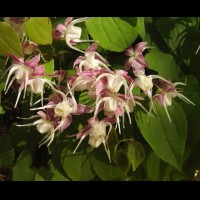
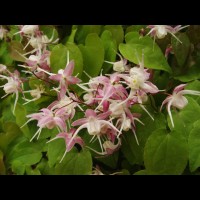
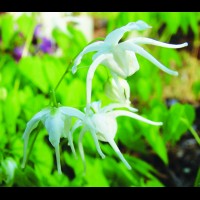
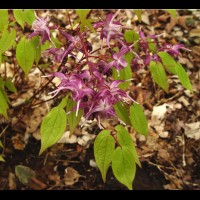
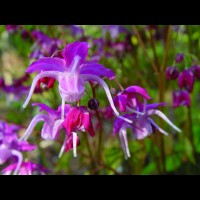

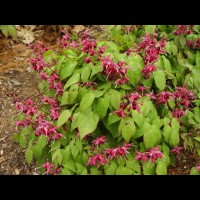
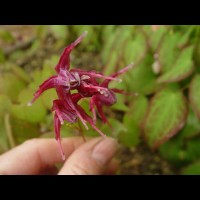
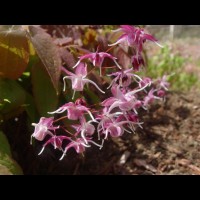
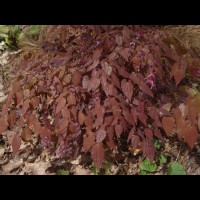
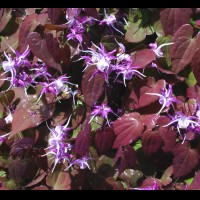
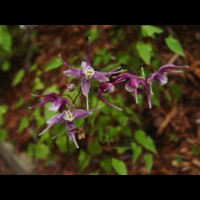
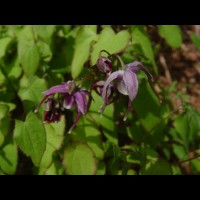

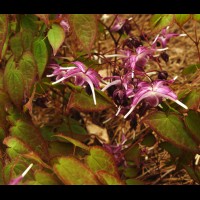
.jpg)

